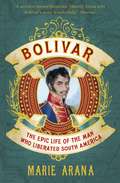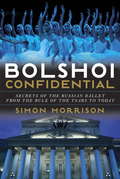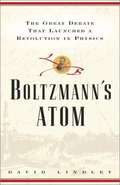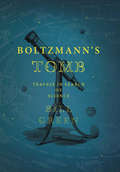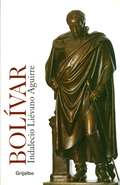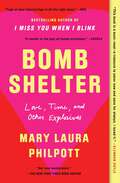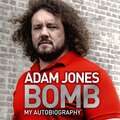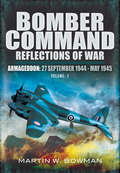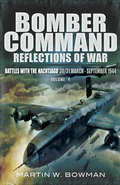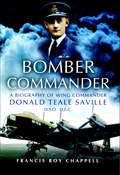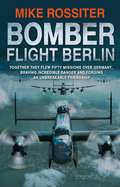- Table View
- List View
Bolivar: The Epic Life of the Man Who Liberated South America
by Marie AranaThe dramatic life of the revolutionary hero Bolivar, who liberated South America - a sweeping narrative worthy of a Hollywood epic.Simón Bolivar's life makes for one of history's most dramatic canvases, a colossal narrative filled with adventure and disaster, victory and defeat. This is the story not just of an extraordinary man but of the liberation of a continent.A larger-than-life figure from a tumultuous age, Bolívar ignited a revolution, liberated six countries from Spanish rule and is revered as the great hero of South American history. In a sweeping narrative worthy of a Hollywood epic, BOLIVAR colourfully portrays this extraordinarily dramatic life. From his glorious battlefield victories to his legendary love affairs, Bolívar emerges as a man of many facets: fearless and inspiring general, consummate diplomat, passionate abolitionist and gifted writer.
Bolshoi Confidential: Secrets of the Russian Ballet from the Rule of the Tsars to Today
by Simon MorrisonIn this enthralling, definitive new history of the Bolshoi Ballet, sensational performances onstage compete with political machinations backstage.On January 17, 2013, a hooded assailant hurled acid into the face of the artistic director of the Bolshoi Ballet, making international headlines. A lead soloist, enraged by institutional power struggles, later confessed to masterminding the crime. The scandal, though shocking, is not an anomaly in the turbulent and tormented yet magnificent history of the Bolshoi. Renowned music historian Simon Morrison reveals the ballet as a crucible of art and politics, beginning with the disreputable inception of the theatre in 1776 and proceeding through the era of imperial rule, the chaos of revolution, the oppressive Soviet years, and the recent $680 million renovation project. Drawing on exclusive archival research, Morrison creates a richly detailed tableau of the centuries-long war between world-class art and life-threatening politics that has defined this storied institution. As Morrison makes clear, as Russia goes, so goes the Bolshoi Ballet.
Bolt Of Fate: Benjamin Franklin And His Fabulous Kite
by Tom TuckerEvery schoolchild in America knows that Benjamin Franklin flew a kite during a thunderstorm in the summer of 1752. Electricity from the clouds above traveled down the kite's twine and threw a spark from a key that Franklin had attached to the string. He thereby proved that lightning and electricity were one. What many of us do not realize is that Franklin used this breakthrough in his day's intensely competitive field of electrical science to embarrass his French and English rivals. His kite experiment was an international event and the Franklin that it presented to the world-a homespun, rural philosopher-scientist performing an immensely important and dangerous experiment with a child's toy-became the Franklin of myth. In fact, this sly presentation on Franklin's part so charmed the French that he became an irresistible celebrity when he traveled there during the American Revolution. The crowds and the journalists, and the ladies, cajoled the French powers into joining us in our fight against the British. What no one has successfully proven until now-and what few have suggested-is that Franklin never flew the kite at all. Benjamin Franklin was an enthusiastic hoaxer. And with the electric kite, he performed his greatest hoax. As Tucker shows, it was this trick that may have won the American Revolution.
Boltzman's Atom
by David LindleyDescribes the history of Boltzman and his work in discovering atoms. Also goes into the philosophical debates involved.
Boltzmann's Tomb
by Bill GreenA selection of the Scientific American book clubRecommended by MSNBC, Los Angeles Times, & American Association for the Advancement of Science's SB&F magazine"This wonderful scientific memoir captures the romance and beauty of research in precise poetic prose that is as gorgeous and evocative as anything written by Rilke, painted by Seurat, or played by Casals." -Mary Doria Russell, author of Doc and The Sparrow"A radiant love letter to science from a scientist with a poet's soul . . . Green is an exquisite writer, and his fierce focus and mastery of style are reminiscent of the biologist and essayist Lewis Thomas." -Kirkus ReviewsIn Boltzmann's Tomb, Bill Green interweaves the story of his own lifelong evolution as a scientist, and his work in the Antarctic, with a travelogue that is a personal and universal history of science. Like Richard Holmes' The Age of Wonder-this book serves as a marvelous introduction to the great figures of science. Along with lyrical meditations on the tragic life of Galileo, the wildly eccentric Tycho Brahe, and the visionary Sir Isaac Newton, Green's ruminations return throughout to the lesser-known figure of Ludwig Boltzmann. Using Boltzmann's theories of randomness and entropy as a larger metaphor for the unpredictable paths that our lives take, Green shows us that science, like art, is a lived adventure. Bill Green is a geochemist and professor emeritus at Miami University in Oxford, Ohio. He is also the author of Water, Ice & Stone: Science and Memory on the Antarctic Lakes which received the American Museum of Natural History's John Burroughs Award for Nature Writing, was a finalist for the PEN/Martha Albrand Award, and was excerpted in The Ends of the Earth: An Anthology of the Finest Writing on the Arctic and the Antarctic, edited by Elizabeth Kolbert.
Boltzmanns Atom: The Great Debate That Launched A Revolution In Physics
by David LindleyIn 1900 many eminent scientists did not believe atoms existed, yet within just a few years the atomic century launched into history with an astonishing string of breakthroughs in physics that began with Albert Einstein and continues to this day. Before this explosive growth into the modern age took place, an all-but-forgotten genius strove for forty years to win acceptance for the atomic theory of matter and an altogether new way of doing physics. Ludwig Boltz-mann battled with philosophers, the scientific establishment, and his own potent demons. His victory led the way to the greatest scientific achievements of the twentieth century. Now acclaimed science writer David Lindley portrays the dramatic story of Boltzmann and his embrace of the atom, while providing a window on the civilized world that gave birth to our scientific era. Boltzmann emerges as an endearingly quixotic character, passionately inspired by Beethoven, who muddled through the practical matters of life in a European gilded age. Boltzmann's story reaches from fin de siècle Vienna, across Germany and Britain, to America. As the Habsburg Empire was crumbling, Germany's intellectual might was growing; Edinburgh in Scotland was one of the most intellectually fertile places on earth; and, in America, brilliant independent minds were beginning to draw on the best ideas of the bureaucratized old world. Boltzmann's nemesis in the field of theoretical physics at home in Austria was Ernst Mach, noted today in the term Mach I, the speed of sound. Mach believed physics should address only that which could be directly observed. How could we know that frisky atoms jiggling about corresponded to heat if we couldn't see them? Why should we bother with theories that only told us what would probably happen, rather than making an absolute prediction? Mach and Boltzmann both believed in the power of science, but their approaches to physics could not have been more opposed. Boltzmann sought to explain the real world, and cast aside any philosophical criteria. Mach, along with many nineteenth-century scientists, wanted to construct an empirical edifice of absolute truths that obeyed strict philosophical rules. Boltzmann did not get on well with authority in any form, and he did his best work at arm's length from it. When at the end of his career he engaged with the philosophical authorities in the Viennese academy, the results were personally disastrous and tragic. Yet Boltzmann's enduring legacy lives on in the new physics and technology of our wired world. Lindley's elegant telling of this tale combines the detailed breadth of the best history, the beauty of theoretical physics, and the psychological insight belonging to the finest of novels.
Bolívar
by Indalecio Liévano AguirreLa más completa biografía del gran Libertador en las letras de uno delos mejores escritores de historia en Colombia. Atesorado como la mejor biografía del Libertador jamás escrita #y ya soninumerables-, este libro nos invita a mirar de cerca la intensa vida deun hombre excepcional, a la vez soldado, político, escritor, legisladory humanista. Sus épicas batallas, sus ideales, sus tormentosos romances,sus formidables enemigos y sus escasos amigos, su pensamiento, todo estáaquí narrado con impecable maestría. #La esclavitud es hija de las tinieblas, un pueblo ignorante es elinstrumento ciego de su propia destrucción
Bolívar and the War of Independence: Memorias del General Daniel Florencio O'Leary Narración (Texas Pan American Series)
by Daniel Florencio O'Leary&“Without a doubt the best work ever published in the English language on the life and deeds of Simón Bolivar. . . . Full of interesting vignettes.&” ―Inter-American Review of Bibliography The overthrow of Spanish rule and the birth of new republican governments in northern South America at the dawn of the nineteenth century were in large part the work of one man—Simón Bolívar. Bolívar was not only the soldier who built a patriot army from a small band of exiles and led them victoriously across Venezuela and down the spine of the Andes as far as Potosí; he was also the statesman who framed the new republics and called the Congress of Panama in pursuit of his dream of uniting all the South American republics in a single confederation. He was, truly, the Liberator. This narrative by his friend and chief aide, Daniel Florencio O&’Leary, has long been recognized by Spanish American scholars as one of the most important historical sources for a major part of Bolívar&’s life. O&’Leary took an active part in the wars for independence, first as a young officer recruited in the British Isles, and later was entrusted with diplomatic missions. His firsthand knowledge of the events of the period, his access to relevant documents, and his close association with major figures in the struggle made O&’Leary a particularly valuable chronicler and biographer. Bolívar himself, shortly before his death, requested that O&’Leary write the story of his life. O&’Leary&’s meticulous attention to military and diplomatic maneuvers and his keen, sometimes acrid, comments on both men and events give not only a vivid portrait of Bolívar—the man and his achievements—but also a remarkable insight into the autocratic-minded O&’Leary. Though O&’Leary&’s devotion to, and admiration for, his Chief make for an occasionally partisan view, his stark account of the hardships and disappointments that Bolívar and his armies overcame against almost impossible odds does much to balance the narrative. In his abridged translation, Robert McNerney has omitted the Apéndice, documents that O&’Leary, had he lived, undoubtedly would have used as the source for completing his account of Bolívar&’s life. Numerous letters and documents scattered through the original text also have been omitted, leaving a highly readable biography.
Bolívar: Libertador de América
by Marie AranaUn relato biográfico vibrante que captura la épica historia de Simón Bolívar, El Libertador. Simón Bolívar se ganó el sobrenombre de El Libertador tras poner fin al dominio español sobre seis países. Su vida fue heroica, trágica y legendaria: viajó del Amazonas a los Andes, libró eternas batallas, forjó alianzas entre razas rivales... Partiendo de un gran abanico de fuentes, Marie Arana captura un vívido retrato de la Suramérica de inicios del siglo XIX, la que forjó a Bolívar y lo convirtió en un valeroso general, un estratega brillante, un escritor portentoso y un político sin parangón; en definitiva, uno de los personajes más admirados de Latinoamérica. Bolívar es una biografía trepidante en la que el lector hallará la imagen de una vida trágica capturada en todo su esplendor y un conmovedor manifiesto de la verdadera esencia del pueblo latinoamericano. Reseñas:«Al fin Bolívar tiene la gran biografía que merece. Ha sido el mayor líder de la historia de Latinoamérica y su vida está repleta de lecciones sobre la pasión y el liderazgo. Este libro se lee con la facilidad de una magnífica novela, pero como obra histórica, su nivel de documentación la pone a la altura de una obra maestra.»Walter Isaacson «Bolívar tiene un enfoque magistral, es una obra construida con un sentido histórico y un estilo casi cinematográficos. Un logro impresionante, destinado a ganar premios literarios destacados.»Joseph J. Ellis, Washington Post Book World «Maravilloso. En este relato de Arana, tan ameno como intenso, Bolívar cobra vida, una vida épica. Contribuye a definir la biografía de Bolívar con una fuerza y un estilo fuera de lo común.»Hector Tobar, The Los Angeles Times «Arana aporta un lúcido testigo de los ideales, las alianzas y de la debilidad humana que condicionaron a Bolívar en sus decisiones y que, por consiguiente, cambiaron el cursode la historia en las Américas.»The New Yorker «Con gran intuición, Arana captura con destreza la audacia y la brillantez de Simón Bolívar, un líder venerado y menospreciado a su vez.»Kirkus Reviews «Arana es una investigadora incansable, una historiadora intuitiva y una escritora brillante, lo cual queda reflejado a la perfección en esta definitiva y sobrecogedora biografía del gran Simón Bolívar, el libertador de América del sur.»Booklist (Top 10 Biografías del año) «La prosa de Arana puede llegar a ser preciosa. Una novelista convertida en historiadora, su relato de la historia de Bolívar es maravillosa. Dos siglos después de su muerte, Bolívar sigue desatando pasiones como no logran hacerlo otros personajes más célebres. En la biografía de Arana descubrimos el porqué.»Giles Tremlett, The Guardian «Se lee como una novela, repleta de retratos, escenarios y escenas memorables y construida con mucho brío y con detalles realmente vívidos.»Enrique Krauze, The New York Times Review of Books «Una biografía extraordinariamente equilibrada y empática. [Arana] tiene un gran instinto cuando se trata de hacer que los detalles cobren vida.»Nicholas Shakespeare, The Telegraph
Bomb Disposal in World War Two
by Chris RanstedFor this book, Chris Ransted has researched some of the lesser known events and personalities relating to the early years of Explosive Ordnance Disposal in the UK. Daring acts of cold blooded bravery, and ingenuity in the face of life threatening technical challenges, are recounted throughout the book.Included are numerous previously unpublished accounts and photographs that describe the disarming of German bombs, parachute mines, and even allied bombs found at aircraft crash sites. In addition, the book contains the most comprehensive account ever published of the Home Guards role with the Auxiliary Bomb Disposal Units, and details of conscientious objectors involvement with unexploded bombs.This is not only a valuable research tool for serious researchers already well read on the subject, but also a fascinating read for those with no previous knowledge of wartime bomb disposal at all, and of course a must read for anyone interested in the subject.
Bomb Season in Jakarta: A personal account of a turbulent period in Australian diplomacy
by Grant DooleyIn the history of Australian diplomacy, the Jakarta post between 2004 and 2007 looms larger than any other. In the span of just a few years, a terrorist bomb attack partially destroyed the Embassy compound, killing eleven; the Boxing Day tsunami wreaked havoc on an almost incomprehensible scale; a bombing in Bali killed twenty, including four Australians; Schapelle Corby divided public opinion; members of the Bali Nine were arrested and convicted; and a Garuda flight crashed and exploded in Yogyakarta, killing twenty, including members of the Australian diplomatic corps. Working in a diplomatic posting in Jakarta at the time, not only did Grant Dooley bear witness to these events, but he was also a first responder in the Embassy bombing and plane crash. And when he wasn't dealing with emergencies and constant terror threats, he had to delicately manage Australia's political leaders, from Alexander Downer to John Howard to Bronwyn Bishop. Somehow, Grant and his wife, Kristan, who worked on the consular staff, kept it all together for themselves and their young family. Or did they?Bomb Season in Jakarta is an incredible up close and personal account of an unparalleled period in Australian diplomacy.
Bomb Shelter: Love, Time, and Other Explosives
by Mary Laura PhilpottFrom the bestselling author of I Miss You When I Blink and &“writer of singular spark and delight&” (Elizabeth Gilbert, #1 New York Times bestselling author) comes a poignant and powerful new memoir that tackles the big questions of life, death, and existential fear with humor and hope.A lifelong worrier, Philpott always kept an eye out for danger, a habit that only intensified when she became a parent. But she looked on the bright side, too, believing that as long as she cared enough, she could keep her loved ones safe. Then, in the dark of one quiet, pre-dawn morning, she woke abruptly to a terrible sound—and found her teenage son unconscious on the floor. In the aftermath of a crisis that darkened her signature sunny spirit, she wondered: If this happened, what else could happen? And how do any of us keep going when we can&’t know for sure what&’s coming next? Leave it to the writer whose critically acclaimed debut had us &“laughing and crying on the same page&” (NPR) to illuminate what it means to move through life with a soul made of equal parts anxiety and optimism (and while she&’s at it, to ponder the mysteries of backyard turtles and the challenges of spatchcocking a turkey). Hailed by The Washington Post as &“Nora Ephron, Erma Bombeck, Jean Kerr, and Laurie Colwin all rolled into one,&” Philpott returns in her distinctive voice to explore our protective instincts, the ways we continue to grow up long after we&’re grown, and the limits—both tragic and hilarious—of the human body and mind.
Bomb no bomb: 13 years in Trento in 1967
by Cristiana PivariAnnalisa is a teenager who lives in Trento during the time of South Tyrolean terrorism, an era when the Southtyrol-freedom committee, which goal was the autodetermination of the region, through the secession from Italy and annexion to Austria, thus obtaining, under the sovereignity of this last one, the politic unification of the historical region of Tyrol, puts bombs everywhere as an intimidatory act. Annalisa is scared of the bombs and seeks on the Grandpa’s newspapers anything related to the topic, but she’s just a little girl after all, who falls in love with a schoolmate, has her first period and writes everything in detail in her diary. Then the bomb explodes also in Trento station, and at the same time a girl is found dead in a fuel tank. News that shocks the young Annalisa, but doesn't stop her to peacefully live her puberty, because life always trumps everything after all.
Bomb: My Autobiography
by Adam JonesIn rugby, there are the Flash Harrys and the Glory Boys: the fly-halves who run, kick and dazzle; the scrum-halves who nip and dart; the wingers who step and glide. These are the players who get the crowd on their feet, who set stadiums abuzz. But they only get to do these things because other, less glorified figures do all of the donkey work. Adam Jones is one such figure. And for a decade he was one of the world's best. On many occasions when George North or Shane Williams were careering under the posts to score a try, and the crowd was engulfed in rapturous joy, Adam Jones would be hauling himself up from the turf, spitting blood and mud, and massaging his aching neck. He hadn't scored the try; but more often than not it was his graft and strength which had made it. This is the story of 'Bomb': the self-effacing manual labourer from the Swansea Valley who traded laying paving slabs for running out in some of the world's most imposing sporting citadels. He rose to the pinnacle of his sport, winning virtually everything there was to be won: Grand Slams, Six Nations Championships, Lions tours, Pro12 titles. In a nation of rugby heroes, Adam Jones has become a legend. Only six Welshmen can say they've won three Grand Slams. He is one of them: not just as a bit-part player, but as the beating heart of the most successful squad in Welsh rugby history. His was one of the first names on the team sheet. He was - literally and metaphorically - the cornerstone of this Welsh side. In his autobiography, Jones reveals exactly what goes on in the murky depths of the front row: the tricks, the techniques, the physical and psychological warfare; and the mental fortitude it takes to endure in one of the hardest positions, in one of the world's toughest contact sports.
Bomb: My Autobiography
by Adam JonesIn rugby, there are the Flash Harrys and the Glory Boys: the fly-halves who run, kick and dazzle; the scrum-halves who nip and dart; the wingers who step and glide. These are the players who get the crowd on their feet, who set stadiums abuzz. But they only get to do these things because other, less glorified figures do all of the donkey work. Adam Jones is one such figure. And for a decade he was one of the world's best. On many occasions when George North or Shane Williams were careering under the posts to score a try, and the crowd was engulfed in rapturous joy, Adam Jones would be hauling himself up from the turf, spitting blood and mud, and massaging his aching neck. He hadn't scored the try; but more often than not it was his graft and strength which had made it. This is the story of 'Bomb': the self-effacing manual labourer from the Swansea Valley who traded laying paving slabs for running out in some of the world's most imposing sporting citadels. He rose to the pinnacle of his sport, winning virtually everything there was to be won: Grand Slams, Six Nations Championships, Lions tours, Pro12 titles. In a nation of rugby heroes, Adam Jones has become a legend. Only six Welshmen can say they've won three Grand Slams. He is one of them: not just as a bit-part player, but as the beating heart of the most successful squad in Welsh rugby history. His was one of the first names on the team sheet. He was - literally and metaphorically - the cornerstone of this Welsh side. In his autobiography, Jones reveals exactly what goes on in the murky depths of the front row: the tricks, the techniques, the physical and psychological warfare; and the mental fortitude it takes to endure in one of the hardest positions, in one of the world's toughest contact sports.
Bomb: My Autobiography
by Adam JonesIn rugby, there are the Flash Harrys and the Glory Boys: the fly-halves who run, kick and dazzle; the scrum-halves who nip and dart; the wingers who step and glide. These are the players who get the crowd on their feet, who set stadiums abuzz. But they only get to do these things because other, less glorified figures do all of the donkey work. Adam Jones is one such figure. And for a decade he was one of the world's best. On many occasions when George North or Shane Williams were careering under the posts to score a try, and the crowd was engulfed in rapturous joy, Adam Jones would be hauling himself up from the turf, spitting blood and mud, and massaging his aching neck. He hadn't scored the try; but more often than not it was his graft and strength which had made it. This is the story of 'Bomb': the self-effacing manual labourer from the Swansea Valley who traded laying paving slabs for running out in some of the world's most imposing sporting citadels. He rose to the pinnacle of his sport, winning virtually everything there was to be won: Grand Slams, Six Nations Championships, Lions tours, Pro12 titles. In a nation of rugby heroes, Adam Jones has become a legend. Only six Welshmen can say they've won three Grand Slams. He is one of them: not just as a bit-part player, but as the beating heart of the most successful squad in Welsh rugby history. His was one of the first names on the team sheet. He was - literally and metaphorically - the cornerstone of this Welsh side. In his autobiography, Jones reveals exactly what goes on in the murky depths of the front row: the tricks, the techniques, the physical and psychological warfare; and the mental fortitude it takes to endure in one of the hardest positions, in one of the world's toughest contact sports.(P)2015 Headline Digital
Bombay Anna: The Real Story and Remarkable Adventures of the King and I Governess
by Susan MorganThis biography shows, the real life of Anna Leonowens was far more fascinating than the beloved story of the Victorian governess who went to work for the King of Siam.
Bombe, keine Bombe
by Cristiana PivariAnnalisa ist ein Teenager, der zur Zeit des Südtiroler Terrorismus in Trient lebt. Die Selbstbestimmung Südtirols, die Abspaltung von Italien und die Annexion an Österreich, um unter dessen Souveränität die Vereinigung der historischen Region Tirol zu erreichen, wurde nachdrücklich verfolgt. Bomben wurden platziert. Annalisa hat Angst vor Bomben.Sie sucht in den Zeitungen ihres Großvaters nach allem, was damit zu tun hat. Aber sie ist noch ein kleines Mädchen und verliebt sich schließlich in einen Schulfreund, bekommt ihre Menstruation und notiert alles sorgfältig in ihrem Tagebuch. Dann explodiert eine Bombe im Bahnhof von Trient, gleichzeitig wird ein Mädchen tot aufgefunden. Das sind Fakten, die Annalisa aufwühlen, die sie aber nicht daran hindern ihre Jugend zu leben, denn am Ende dominiert das Leben.
Bomber Boys: Dramatic and True Life Experiences Over Occupied Europe, 1942—45
by Mel Rolfe&“Expertly researched . . . 20 different narratives in which these heroes venture out night after night on sorties throughout World War II Europe.&” —Plane and Pilot Three weeks after Stirling air gunner Doug Fry was reported missing over Germany his mother was still clinging to the vain hope that he was alive. Then a neighbor said she had seen him in the cinema just down the road. The airman and his crew had been filmed for a Bomber Command documentary shortly before they took off from Mildenhall to attack Remscheid. Three hours later four of the crew were killed, but it was another two months after she had also seen the poignant film that widowed mother of eight Winnie Fry knew her nineteen-year-old son, though wounded, was still alive. Lancaster pilot Victor Wood&’s aircraft arrived too early over Gelsenkirchen when the target was shrouded in darkness and the Main Force was miles behind. His 12 Squadron bomber was suddenly struck with terrifying force by flak and turned upside-down. An engine was on fire, the unconscious mid-upper gunner, slumped in his turret, was being sprayed with petrol and their bomb-load had been struck by shrapnel. Could Vic Wood get his crew back to base safely? These are just two of twenty dramatic Bomber Command stories in Bomber Boys. Night after night, the young men, some just out of school, went off on sorties, having pushed to the back of their minds the unpalatable awareness that they might never see another dawn. If death did not find them on the first few terrifying sorties they grew up very quickly in order to fight another day.
Bomber Command: Armageddon, 27 September 1944–May 1945 (Bomber Command #5)
by Martin W. BowmanThis is the fifth release in a series that provides a comprehensive insight into all aspects of RAF Bomber Command in World War Two. It begins in late September 1944 when the Allied Bomber Offensive was at its height, and takes us through to the end of the conflict. The crews' personal narrative puts you at the centre of each intense, isolated and harrowing episode of aerial combat as the pilots of Bomber Command attempted to stave off fears of tragic injury and death from fighters, flak and incessant operational pressure during raids on German cities, waterways, ports and oil installations. This continued until the Luftwaffe and the Nachtjagd effectively ceased to exist, their fuel supplies exhausted, their losses in airmen reaching an unsustainable level, and their aircraft and airfields decimated as a result of 24-hour Allied bombing.Often, it was the most exciting feats of bravery, determination and daring that were marked by the most catastrophic losses. Approximately 62 per cent of the 125,000 men who served as aircrew in Bomber Command during the war became casualties. Of these, 52 per cent were sustained while flying operations and a further ten per cent while on non-operational flights in Britain. It should never be forgotten that RAF Bomber Command played a hugely significant role in securing victory for the Allies, carrying out mass raids by day and night that eventually culminated in them 'beating the life out of Germany'. Yet its crews were denied the campaign medal that they so richly deserved, until very recently. Here, Martin Bowman attempts to provide an adequate tribute to the men of Bomber Command, using first-hand accounts to capture an authentic commentary of the times at hand in a release that is sure to capture the imaginations of all aviation enthusiasts.
Bomber Command: Battles with the Nachtjago 30/31 March–September 1944 (Bomber Command #4)
by Martin W. BowmanThis, the fourth volume of a five part work that provides a comprehensive insight into all aspects of RAF Bomber Command in World War Two, begins in the spring of 1944 with a completely new insight on the catastrophic raid on Nuremburg on the night of 30/31 March and follows with the disastrous attack on Mailly-le-Camp in May. Gradually, the Allied Bomber Offensive began to bear fruit and in June 1944 the invasion of Normandy took place under an umbrella of almost total Allied air superiority. RAF Bomber Command was to play a huge part in what proved to be the final steps to ultimate victory, returning to the mass raids on German cities by night and even mounting raids on the Reich by day. The authors well-tried formula of using background information interspersed with the crews personal narrative takes you raid by raid through each tour of ops while carrying full bomb loads in sub-zero temperatures, blighted by atrocious weather conditions and dogged by fear of fire, death or serious injury or having to endure months if not years of miserable existence and near starvation behind the wire in notorious PoW camps. The path to peace was paved with the unmitigated slow ebbing of courage with an ever-present possibility of death unannounced from a prowling night fighter, nondescript and unseen, as night after incessant night, shattered and ailing bombers could run out of luck to crash in some foreign field while other crews, almost home almost empty - ran out of fuel and died horrible tortuous deaths in twisted and tangled wreckage. Not for them the glory that was accorded The Few but as Winston Churchill said: Fighters are our salvation, but the bombers alone provide the means of victory.
Bomber Command: Live to Die Another Day June 1942–Summer 1943 (Bomber Command)
by Martin W. BowmanThis massive work provides a comprehensive insight to the experiences of Bomber Commands pilots and aircrew throughout WWII. From the early wartime years when the RAFs first attempts to avenge Germanys onslaught were bedeviled by poor navigation and inaccurate bombing, to the last winning onslaught that finally tamed Hitler in his Berlin lair, these volumes trace the true experiences of the men who flew the bombers. Hundreds of firsthand accounts are punctuated by the authors background information that puts each narrative into wartime perspective. Every aspect of Bomber Command's operational duties are covered; day and night bombing, precision low-level strikes, mass raids and operations throughout all wartime theaters. Contributions are from RAF personnel who flew the Commands different aircraft from the early Blenheims and Stirlings to the later Lancasters and Mosquitoes.Each volume is full of accounts that tell of the camaraderie amongst the crews, moments of sheer terror and the stoic humor that provided the critical bond. The five volumes of this work provide the most vivid and comprehensive work on the outstanding part played by RAF Bomber Command and their vital role in the destruction of the Third Reich.
Bomber Commander: A Biography of Wing Commander Donald Teale Saville DSO, DFC
by Francis Roy ChappellWing Commander Donald Teale Saville DSO, DFC joined the Royal Australian Air Force in 1927. From 1932 until 1939 he flew and tested private aircraft, was a flying instructor and then a Captain-pilot with Australian National Airways. In 1936, at the age of 36 years, he volunteered for the RAF whilst on holiday in England. Because of his age he was posted to the Ferry Pool Service and eventually became its Commanding Officer. In 1941 he dropped rank from Squadron Leader to Flight Lieutenant to join Bomber Command, and in December of that year joined No 458 RAAF Squadron flying Wellingtons as a Flight Commander. In 1942 he was appointed to command another Wellington squadron, No 104, at Kabrit in Egypt. He was awarded the DFC for daring operations whilst flying from Malta against enemy airfields and ports. In March 1943 he took command of No 218 Squadron at Downham Market flying somewhat elderly Short Stirlings and at a time of intolerable losses. In July 1943 he went missing on the first mass bombing raid on Hamburg. He made the supreme sacrifice by holding his burning aircraft steady while four of his crew escaped by parachute.He was known affectionately as 'The Mad Aussie' and was reputed to have flown 10,000 flying hours. He was fifteen or so years older than most of his aircrews and was probably the oldest pilot in Bomber Command. At the time of his loss he was in was on his third tour of operations.This is the story of a man who carried leadership by example and was renowned as an exceptionally skilled, daring and confident aviator.
Bomber Flight Berlin
by Mike Rossiter'We believed in ourselves so much, no one ever panicked, even when the situation looked so desperate. We all believed that our best chance of staying alive was to stick together.'Flying Lancaster bombers was one of the most dangerous missions of the war. Yet night after night Flight Lieutenant Geoffrey King and the crew of C Charlie risked their lives in the skies over Germany. Together they faced incredible dangers, flak damage, close encounters with the fighter planes of the Luftwaffe, and crash landings. Against this background a friendship was formed that bound the crew of C Charlie together against all odds.Geoffrey King and the crew of C Charlie are unique in having flown together for fifty missions and living to tell the tale. Bomber Flight Berlin is the story of a group of ordinary men, from different walks of life, thrown together by the forces of war. It is the story of those missions above Berlin, as they flew into what seemed certain death, and aircraft all around them were blasted out of the sky. It is also a testament to a remarkable friendship.
Bomber Harris: Sir Arthur Harris' Despatches on War Operations 1942–1945
by John GrehanThe bombing campaign conducted against Germany and German-occupied Europe in the Second World War was, and remains, one of the most controversial operations of the entire war. Much of Bomber Command's effort was what was defined as 'area' bombing, in which whole cities or districts were targeted. The ultimate aim of an attack on a town area, Sir Arthur Harris wrote in one of his despatches, is to break the morale of the population which occupies it ... namely, to produce (i) destruction and (ii) fear of death.This strategy was so successful it almost brought Germany to the point of collapse until Churchill, worried about the devastation it was causing and the number of civilian deaths which resulted, ordered it to cease.Harris' despatches explain in great detail the success of his methods which, if given full reign, may have brought the war to a speedier conclusion but would have meant even more German casualties. Such was the controversy surrounding Bomber Command's operations, Harris' despatches were not published by the government, even though the despatches of every other branch of the armed services, and all of their operations, were made public. The full text of Harris' despatches is reproduced here along with an explanation why these documents were withheld for so many years.
